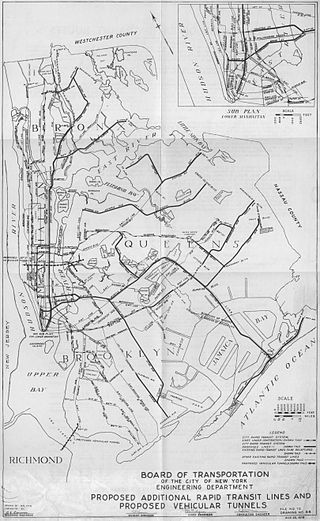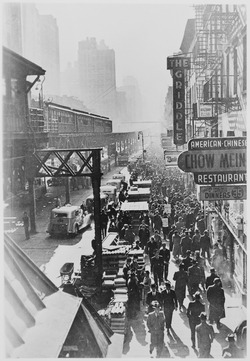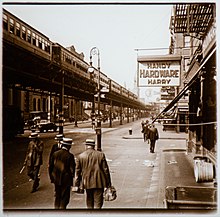
The Brooklyn–Manhattan Transit Corporation (BMT) was an urban transit holding company, based in Brooklyn, New York City, United States, and incorporated in 1923. The system was sold to the city in 1940. Today, together with the IND subway system, it forms the B Division of the modern New York City Subway.

The Independent Subway System, formerly known as the Independent City-Owned Subway System (ICOSS) or the Independent City-Owned Rapid Transit Railroad (ICORTR), was a rapid transit rail system in New York City that is now part of the New York City Subway. It was first constructed as the Eighth Avenue Line in Manhattan in 1932.

Since the opening of the original New York City Subway line in 1904, and throughout the subway's history, various official and planning agencies have proposed numerous extensions to the subway system. The first major expansion of the subway system was the Dual Contracts, a set of agreements between the City of New York and the IRT and the BRT. The system was expanded into the outer reaches of the Bronx, Brooklyn, and Queens, and it provided for the construction of important lines in Manhattan. This one expansion of the system provided for a majority of today's system.

The Interborough Rapid Transit Company (IRT) was the private operator of New York City's original underground subway line that opened in 1904, as well as earlier elevated railways and additional rapid transit lines in New York City. The IRT was purchased by the city in June 1940, along with the younger BMT and IND systems, to form the modern New York City Subway. The former IRT lines are now the A Division or IRT Division of the Subway.

Sixth Avenue – also known as Avenue of the Americas, although this name is seldom used by New Yorkers – is a major thoroughfare in New York City's borough of Manhattan, on which traffic runs northbound, or "uptown". It is commercial for much of its length.

The IRT Ninth Avenue Line, often called the Ninth Avenue Elevated or Ninth Avenue El, was the first elevated railway in New York City. It opened in July 1868 as the West Side and Yonkers Patent Railway, as an experimental single-track cable-powered elevated railway from Battery Place, at the south end of Manhattan Island, northward up Greenwich Street to Cortlandt Street. It ceased operation in June 1940, after it was replaced by the IND Eighth Avenue Line which had opened in 1932.
The IND Sixth Avenue Line is a rapid transit line of the B Division of the New York City Subway in the United States. It runs mainly under Sixth Avenue in Manhattan, and continues south to Brooklyn. The B, D, F, and M trains, which use the Sixth Avenue Line through Midtown Manhattan, are colored orange. The B and D trains use the express tracks, while the F, <F> and M trains use the local tracks.
59th Street station may refer to:
The IRT Dyre Avenue Line is a New York City Subway rapid transit line, part of the A Division. It is a branch of the IRT White Plains Road Line in the northeastern section of the Bronx, north of East 180th Street. As of 2013, it has a daily ridership of 34,802.

The IRT Third Avenue Line, commonly known as the Third Avenue Elevated, Third Avenue El, or Bronx El, was an elevated railway in Manhattan and the Bronx, New York City. Originally operated by the New York Elevated Railway, an independent railway company, it was acquired by the Interborough Rapid Transit Company (IRT) and eventually became part of the New York City Subway system.

The IRT Second Avenue Line, also known as the Second Avenue Elevated or Second Avenue El, was an elevated railway in Manhattan, New York City, United States, from 1878 to 1942. It was operated by the Interborough Rapid Transit Company until 1940, when the city took over the IRT. Service north of the 57th Street station ended on June 11, 1940; the rest of the line closed on June 13, 1942.

The 23rd Street station is a local station on the IND Sixth Avenue Line of the New York City Subway, located at the intersection of 23rd Street and Sixth Avenue in Manhattan. It is served by the F train at all times, the M train during weekdays, and by the <F> train during rush hours in the peak direction. This station and 14th Street are the only two local stations on the Sixth Avenue Line.

The 161st Street–Yankee Stadium station is a New York City Subway station complex shared by the elevated IRT Jerome Avenue Line and the underground IND Concourse Line. It is located at the intersection of 161st Street and River Avenue in the Highbridge and Concourse neighborhoods of the Bronx. It is generally served by the 4 train at all times; the D train at all times except rush hours in the peak direction ; and the B train during rush hours.
42nd Street most commonly refers to:
The 53rd Street and Eighth Avenue station was a station on the demolished IRT Sixth Avenue Line in Manhattan, New York City. It was built in 1881 by the Manhattan Railway Company as part of an effort to connect the northern end of the Sixth Avenue Line to the Ninth Avenue Line. It had three tracks and two side platforms, and was served by trains from the IRT Sixth Avenue Line. As a result, it became the last station on the Sixth Avenue Line before merging at a sharp curve with the Ninth Avenue Line. On September 11, 1905, 12 people were killed and 42 injured when a train jumped over the rails at the curve on 53rd Street between the Ninth Avenue 50th Street and 59th Street stations. In 1932, the Independent Subway System built the 50th Street Station three blocks to the south on the Eighth Avenue Subway with an additional lower level in 1933, thus rendering the elevated station and line obsolete. It closed on December 4, 1938. The next southbound stop was 50th Street. The next northbound stop was 59th Street.
23rd Street station may refer to:













